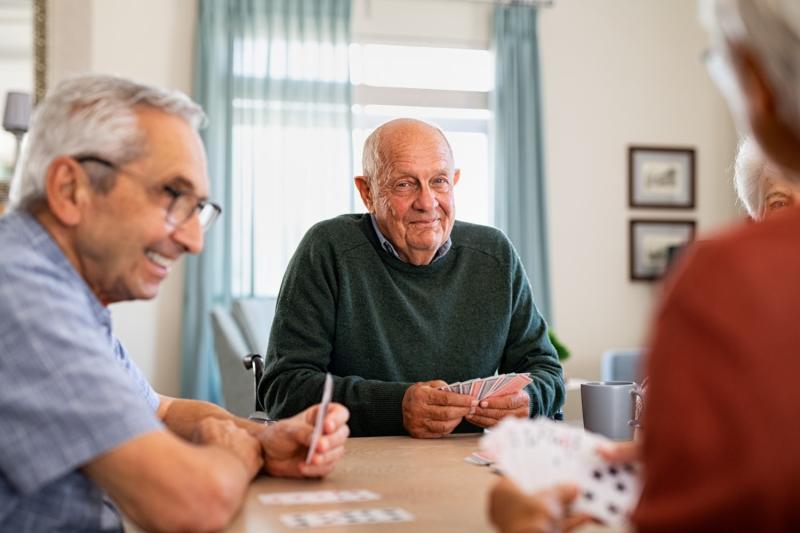Key points
- A multidisciplinary approach to rehabilitation that is tailored to the individual and based at home can improve independent activities of daily living and mobility for aged care users.
- Multidisciplinary care results in better rehabilitation, reablement, and restorative care for service users when performed well. However, barriers to effective multidisciplinary care should be considered for effective service delivery.
- There is strong evidence to support the use of tailored, multidisciplinary, home-based care programs to enable older adults to maintain their independent activities of daily living, and improve memory, executive function, functional status, and everyday problem solving.
Multidisciplinary, interdisciplinary, or interprofessional care as it is sometimes referred to, is when professionals from different disciplines, such as nurses, physiotherapists, and occupational therapists, work together to deliver the best care for an individual patient. Usually, the multidisciplinary team works towards predetermined goals of personal importance to the individual receiving care. This approach uses the diverse perspectives and skills of different healthcare professionals to rehabilitate, re-able, and restore patient function, delivering the highest quality care across a range of settings. [1]
This evidence theme is a summary of one of the key topics identified by a scoping review of rehabilitation, reablement, and restorative care research. If you need more information on this topic, try using the PubMed search below.
We found 14 systematic reviews that reported multidisciplinary approaches to rehabilitation, reablement, and restorative care. Eight of these reviews reported on rehabilitation, six on a reablement approach, and one on restorative care. Overall, the provision of care by multidisciplinary teams was effective in improving independent function when carried out successfully. However, further research using larger samples in the context of aged care is required to improve our understanding of the barriers and facilitators faced in the delivery of multidisciplinary care.
The reviews identified that:
- Multidisciplinary care is often provided in home-based reablement services, by physiotherapists, occupational therapists, and nurses. [2]
- Complex reablement interventions should be committed to person-centred care, using a holistic approach that is provided by trained multidisciplinary staff who can conduct initial and ongoing assessments effectively [3]
- Standardised assessments focussed on meaningful goals should be used in diverse multidisciplinary teams to improve daily function of aged care users [4]
- Reablement programs have been delivered successfully using a multidisciplinary approach, providing interventions in the older person’s own home. However, the barriers and facilitators associated with working in a team when developing, implementing, and evaluating interventions [5] as well as the behaviour, attitudes, and communication of team members should be considered [6]
- Multidisciplinary care coordination has been found to demonstrate positive cost-effective interventions; however further evidence is required [7]
- Individual healthcare professionals should be open to communication and multidisciplinary collaboration to achieve the best possible outcome for aged care users.
- Make sure every member of the team understands their role and responsibilities.
- Ensure direct care workers have a voice within the team as they often have close hand knowledge of the person and any difficulties they are experiencing, such as their level of pain.
Organisations can support multidisciplinary approaches to rehabilitation, reablement, and aged care by:
- Beginning with a well-defined model of multidisciplinary or interdisciplinary care, and work to develop holistic assessments that include reliable and validated outcome tools that can assess the effectiveness of an interprofessional approach. [6]
- Facilitate opportunities for case conferences between all members of the multidisciplinary team. Include the person and their family, wherever possible to discuss individual treatment goals and priorities.
- The roles of providers, consumers and caregivers in any multidisciplinary effort should be explicitly stated to establish collaboration between the team members. [8]
- The importance of a multidisciplinary approach should be integrated into teachings at a tertiary level for healthcare graduates and more informally for caregivers. [9]
- Royal Australian College of General Practitioners. RACGP aged care clinical guide (Silver book) [Internet]. 5th ed. South Melbourne, Vic.: RACGP; 2020. Part B. Collaboration and multidisciplinary team-based care; [cited 2023 Jun 30]. Available from: https://www.racgp.org.au/getattachment/6dcd5b6b-3acb-4ef2-ba2b-efc358f62513/Collaboration-and-multidisciplinary-team-based-car.aspx
- Bersvendsen T, Jungeilges J, Abildsnes E. Empirical evaluation of home-based reablement: A review. Nordic Journal of Health Economics. 2021;9(1).
- Bramble M, Young S, Prior S, Maxwell H, Campbell S, Marlow A, et al. A scoping review exploring reablement models of training and client assessment for older people in primary health care. Primary Health Care Research & Development. 2022;23:e11.
- Buma Lise E SVSZGIJMKSFM. Effects on clients' daily functioning and common features of reablement interventions: a systematic literature review. European Journal of Ageing. 2022.
- Cochrane A, et a. Time-limited home-care reablement services for maintaining and improving the functional independence of older adults (review): John Wiley and Sons Cochrane Collaboration; 2016. 62 p.
- Doornebosch AJ, Smaling HJA, Achterberg WP. Interprofessional Collaboration in Long-Term Care and Rehabilitation: A Systematic Review. Journal of the American Medical Directors Association. 2022;23(5):764-77.e2.
- Flemming J, Armijo-Olivo S, Dennett L, Lapointe P, Robertson D, Wang J, et al. Enhanced Home Care Interventions for Community Residing Adults Compared With Usual Care on Health and Cost-effectiveness Outcomes: A Systematic Review. American Journal of Physical Medicine & Rehabilitation. 2021;100(9):906-17.
- Kalu ME, Maximos M, Sengiad S, Dal Bello-Haas V. The Role of Rehabilitation Professionals in Care Transitions for Older Adults: A Scoping Review. Physical & Occupational Therapy in Geriatrics. 2019;37(3):123-50.
- dos Santos AO, Tier CG, Cogo SB, Lira LG, de Melo de Moura CB, de Melo LN, et al. The Care Provided by the Multi-professional Team to Institutionalized Aged: Integrative Review. Lecture Notes in Bioengineering. 2022:366-77.
Connect to PubMed evidence
This PubMed topic search is limited to home care and residential aged care settings. You can choose to view all citations or citations to articles available free of charge.


